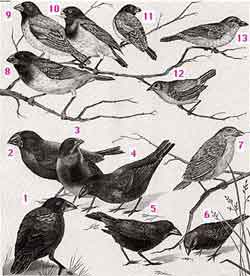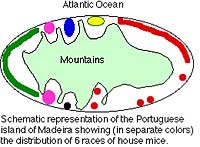 |
|
What is a species?
A biological species is a population of interbreeding organisms that will not breed with other populations. There are exceptions of course to the rule such as mules (infertile offspring of horse and donkey) ligers, and so forth but these hybrids usually do not have generational longevity. Methods that prevent populations may be as simple as geographic isolation but there are often more overlooked reasons... Prezygotic mechanisms before a zygote is formed A) Prevention of mating  ecological isolation - extreme differences in habitat prevents overlap of populations temporal isolation - blooming of similar plants may be out of synch. seasonally or time of day for pollination to occur - migration routes may be blocked due to seasonal variation - mosquitoes come out at different times of the day behavioural isolation - each similar species may use a different signal for attracting a mate such as a different pheromone, mating dance, or song. B) Prevention of Conception  mechanical isolation - mating apparatus prevents coupling hence conception - many of the Galapagos tortoises have carapaces that fit each other according to species on each island gametic isolation - male gametes (sperm or pollen) are often guided to the ovum by various signals if this is not present then conception may not occur.
Postzygotic
Isolation - isolating mechanisms that prevent hybrids from
reproducing |
 Darwin's
finches. The finches numbered 1-7 are ground finches. They seek their food
on the ground or in low shrubs. Those numbered 8-13 are tree finches. They
live primarily on insects. Darwin's
finches. The finches numbered 1-7 are ground finches. They seek their food
on the ground or in low shrubs. Those numbered 8-13 are tree finches. They
live primarily on insects.1. Large cactus finch (Geospiza conirostris) 2. Large ground finch (G. magnirostris) 3. Medium ground finch (Geospiza fortis) 4. Cactus finch (G. scandens) 5. Sharp-beaked ground finch (G. difficilis) 6. Small ground finch (G. fuliginosa) 7. Woodpecker finch (Cactospiza pallida) 8. Vegetarian tree finch (Platyspiza crassirostris) 9. Medium tree finch (Camarhynchus pauper) 10. Large tree finch (Camarhynchus psittacula) 11. Small tree finch (C. parvulus) 12. Warbler finch (Certhidia olivacea) 13. Mangrove finch (Cactospiza heliobates) (From BSCS, Biological Science: Molecules to Man, Houghton Mifflin Co., 1963) |
Sympatric speciation -
this type of speciation occurs less frequently and does
not always involve physical isolation.
physical isolation. - if a sudden mutation occurs within a population that prevents interbreeding then this population might suddenly separate into 2 similar species - the grey frog 2 species H. versicolor + H. chrysocelis are a good example of 2 similar species with overlapping habitats, H. versicolor is tetraploid and the latter is diploid (typical) |
